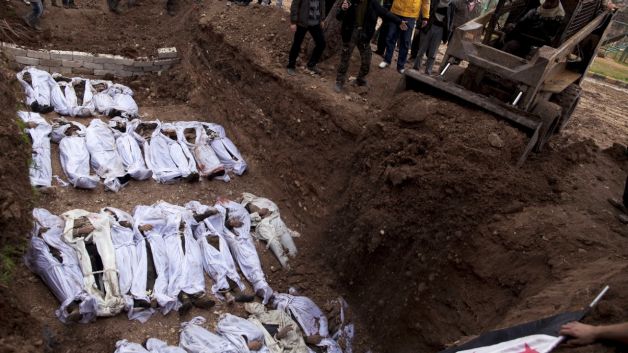
The average life expectancy for Syrians has plummeted by nearly 30 percent as the country’s civil war enters its fifth year, according to a new report from the United Nations.
Before 2011, Syrians could expect to live to, on average, 79.5 years, but nearly five years into the country’s deadly conflict between forces loyal to President Bashar Assad and anti-government rebels, Syrian life expectancy at birth is now just 55.7.
The “silent calamity” of life expectancy in Syria, once on par with European countries like Hungary and Latvia and now on the same level as Burundi, South Sudan and Malawi, is just one aspect of life that has been devastated by the relentless violence, according to the report, titled “Syria: Alienation and Violence, Impact of the Syria Crisis” and published by the United Nations Relief and Works Agency for Palestinian Refugees in the Near East (UNRWA), the United Nations Development Programme and the Syrian Center for Policy Research.
Even as Syrians have been at risk from death, injury and permanent disfigurement from the fighting and shelling, deaths from malnutrition and starvation are increasing, according to the report. Infectious diseases are also making a comeback in the war-torn nation; of particular concern is the resurgence of polio, which reemerged in Syria in October 2013 — more than a decade after the country eradicated the disease. Before the war, heart disease and stroke were among the leading causes of premature death.

Ongoing conflict and the destruction of Syria’s infrastructure by government forces has slashed the life expectancy by more than 20 years in just over four years.
Fighting first broke out after after President Bashar al-Assad’s regime cracked down on peaceful demonstrators in March 2011. The conflict quickly escalated into an all-out civil war, and efforts to bring the conflict to an end have been complicated by the violent rise of the Islamic State, or ISIS, which is trying to establish a caliphate across Syria and Iraq. Pre-existing socioeconomic inequalities, combined with climate change-induced drought, made the country particularly vulnerable and fueled the rapid escalation of the war.
Since then, more than 4 million people have fled the country as refugees, mainly to Jordan, Egypt, Iraq, Lebanon and Turkey, and 40 percent of the population, or 6 million Syrians, have been internally displaced. According to The Economist, Syria has now overtaken Afghanistan to become the world’s biggest source of refugees. Existing Palestinian refugees who settled in Syria during previous outbreaks of violence have also been affected, and more than half of them, already uprooted and in limbo, have been displaced at least once inside Syria, says the UNRWA.
Fighting has also devastated Syria’s economy, which has lost $202.6 billion from the war’s destruction and the loss of capital. Four out of five Syrians are now living below the poverty line, and two-thirds are unable to secure basic food and essentials for daily living. Unemployment is at 58 percent, the report says, and half of all Syrian children haven’t attended school in the past three years.

Eighty percent of the Syrian population is now living in poverty, with two-thirds lacking basic essentials like food and clean water.
On Wednesday, a separate report from New York-based nonprofit Physicians for Human Rights claimed the government was responsible for the deaths of 610 doctors and 32 barrel bomb attacks on 24 medical facilities over the past four years. It said that 139 of them were tortured or executed and that hospitals and medical personnel were “targeted” for their work. In 2014, one medical worker was killed every other day, and every four days a hospital was bombed or shelled, the group says. The group blamed Syrian government forces for 88 percent of its recorded attacks on hospitals and almost all recorded killings of medical workers during the country’s four-year conflict.
The government has previously been accused of mistreatment of its civilian population, including abduction, torture and execution. A new exhibition at the U.N. headquarters in New York shows a series of photos smuggled out of Syria allegedly showing victims of systematic killings by forces loyal to Assad.
